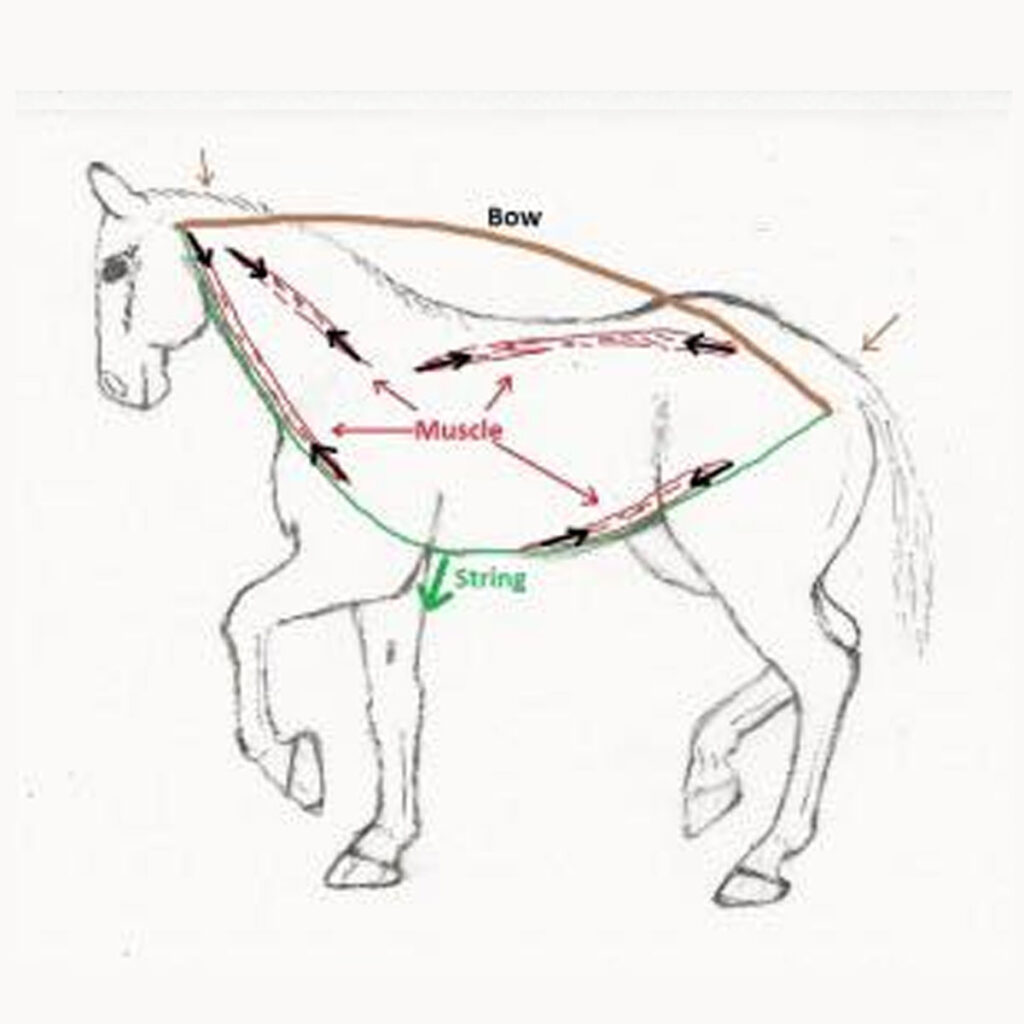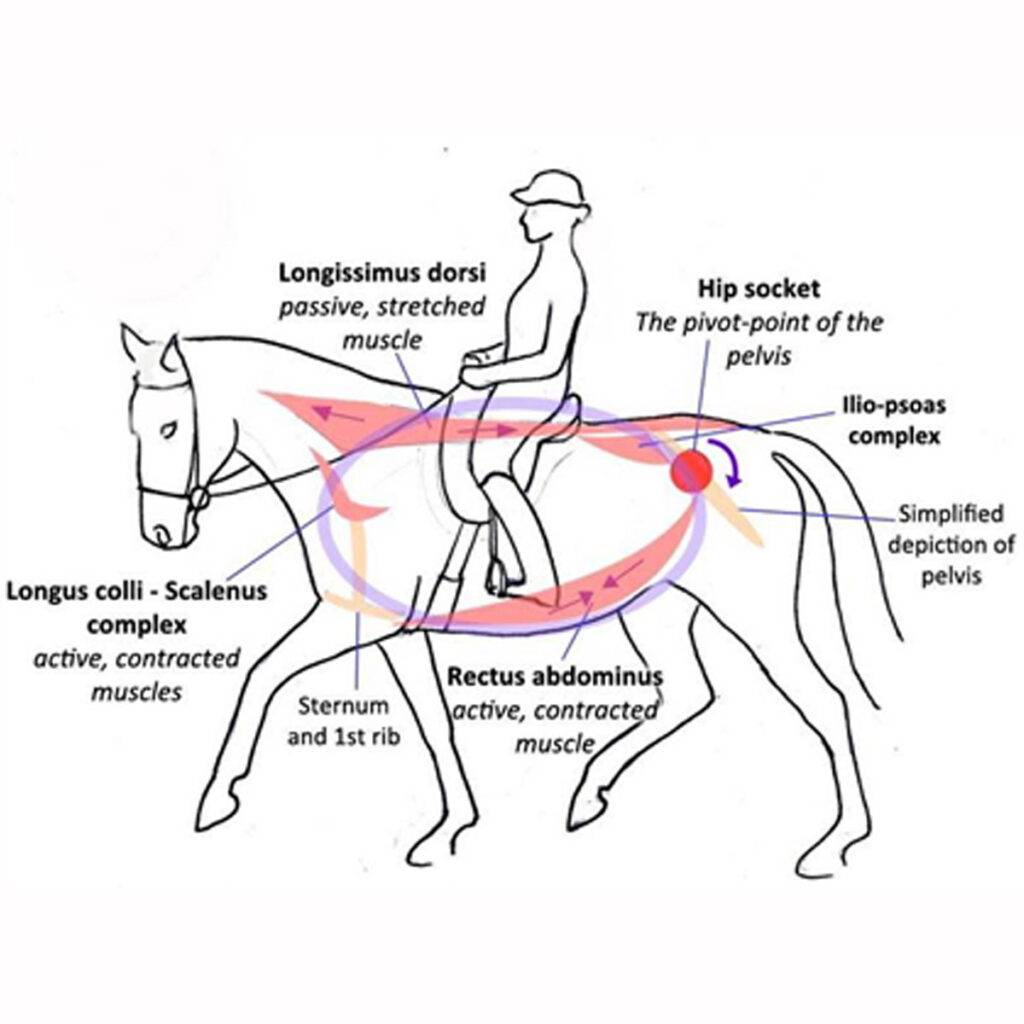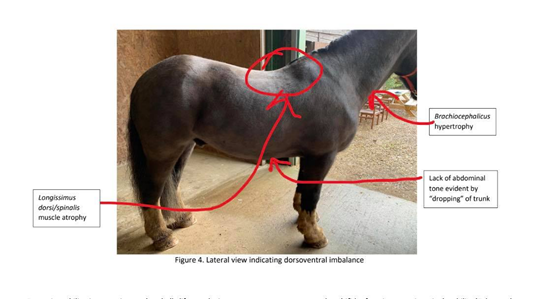Core stability is an important concept to ensure appropriate biomechanical function. Core stability assists with the dorsal ventral chain, and by achieving core stability, contraction of the long back musculature is reduced (de Oliveria et al. 2015), which assists with back function by allowing greater ventral flexion rather than extension (figure 1). Core engagement involves the abdominal musculature, and by engaging muscles such as the rectus abdominis, collection of the hindlimbs increases, resulting in an increase in protraction and range of motion due to its attachment to the coxofemoral joint (Wagner, 2016).


Core engagement is more than simply engaging core musculature but works on the dorsal ventral chain (bow and string theory, figure 2), and is a continuous change in energy through the system. Forward motion is initiated through caudal displacement of the centre of gravity through forward motion of the hindlimb, tilting the pelvis, raising the chest, and with abdominal engagement, spinal flexion, and energy forwards. Once the forelimb touches the ground, energy is then transferred up the stay apparatus to the neck intrinsic musculature such as scalenus, through the back to the extrinsic hindlimb muscles such as iliopsoas complex (figure 3); this makes movement incredibly efficient (Wagner, 2016). If any aspect of this chain is imbalanced it impacts motion, for example a lack of core engagement results in the epaxial musculature having to take over spinal stability, limiting motion, a lack of energy transfer, and creating dysfunction such as a lack of hindlimb protraction (Tabor and Williams, 2017). Greater development of intrinsic neck musculature such as the brachiocephalicus also creates a change in bow and string biomechanics, and results in energy creation from the forelimbs rather than hindlimbs, which is inefficient and results in a lack of neck flexion, or hyperflexion, dependent upon the part being contracted, and a lack of lateral bending (Tokuriki and Aoki, 1991; Kienapfel, 2014)
The horse in the 4th image demonstrates dorsal ventral imbalance, indicated by the lack of abdominal tone and atrophy of the long back muscles, particularly behind the withers. It has also resulted in a hypertrophy of the brachiocephalicus muscle (figure 4) due to a lack of energy creation from the hindlimbs, and using the brachiocephalicus to protract the limb, instead of energy transfer from the hindlimbs assisting with raising the shoulder.


Dynamic mobilisation exercises such as belly lifts results in greater core engagement and multifidus function to assist spinal stability (Tabor and Williams, 2017), alongside tail pulls assisting with iliopsoas function (Higgins, 2019), which is imperative for hindlimb energy creation and pelvic tilt. Raised poles are effective at creating the desired “frame” through core engagement, excitation of the rectus abdominis and reduced use of the longissimus dorsi, allowing for spinal flexion (de Oliveira et al. 2015). This can be achieved in walk and trot, however, walk allows for
contraction of muscles for each joint to assist range of motion, and not utilise the suspension of trot to produce the lift. In addition, the Pessoa training aid has been found to promote core engagement as identified by an increase in collection through a reduction in stride length, speed, and head angle, alongside a greater dorsoventral back displacement of the mid thoracic, without an increase in hindlimb range of motion, suggesting limb structures are not subjected to extra pressure due to the system (Walker and Murray, 2013). Cottriall et al. (2008) also noted the longissimus dorsi was more active with no training aid compared to the Pessoa and side reins, suggesting that core engagement reduces pressure on the longissimus dorsi to mobilise and stabilise the back.
Moral of the story…look after that back! Look for signs for dysfunction such as incorrect musculature, and speak to a therapist to keep your horse in top form
